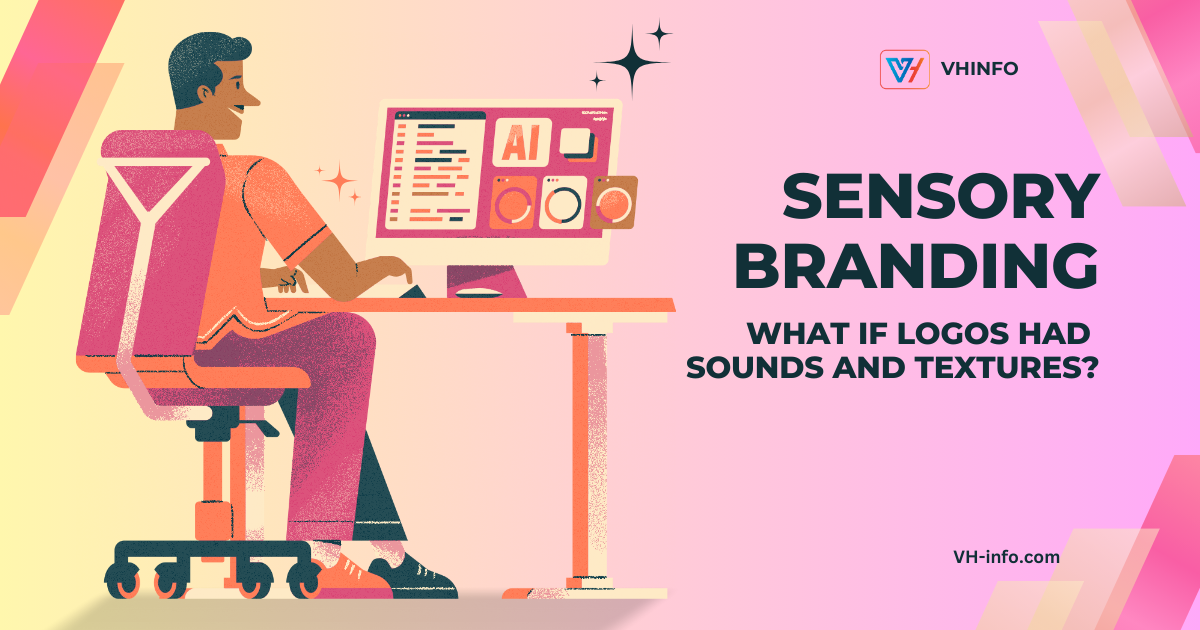Branding is no longer just about visuals. In a world saturated with logos and advertisements, brands must engage more than just the sense of sight to stand out. Sensory branding involves stimulating multiple senses—touch, sound, and even smell—to create deeper emotional connections with consumers. The more senses a brand engages, the stronger and more memorable its identity becomes.
This article has been prepared by the experts at Turbologo, a company specializing in innovative branding solutions. We will explore how logos could evolve beyond static visuals and embrace sound and texture to create a more immersive brand experience.
Logos You Can Hear: How Sound Enhances Branding
Sound branding is already an essential part of marketing, but what if logos themselves had an auditory identity? Some of the most recognizable brands in the world—like Intel, Netflix, and McDonald’s—use unique sound cues that immediately trigger brand recognition. If a logo had an associated sound, it could reinforce memory and create a stronger emotional connection.
Imagine a world where opening a Coca-Cola bottle wasn’t just about seeing the logo but also experiencing the crisp, refreshing fizz as part of the brand’s identity. Auditory elements add a new layer of engagement, making the brand more interactive and immersive.
Feeling a Logo: What If Branding Had Texture?
While most branding is focused on what we see, touch is a powerful yet often overlooked sense in marketing. The feel of a product—whether it’s the smoothness of an iPhone, the embossed texture of a high-end business card, or the soft matte of luxury packaging—affects how we perceive a brand’s quality and personality.
If logos incorporated texture, brands could reinforce their values in a tangible way. A rugged, grainy texture could signify strength and durability for an outdoor brand, while a silky, smooth texture could enhance the elegance of a luxury fashion house. Touch adds a physical connection between the brand and the consumer, making interactions feel more personal and memorable.
How Brands Already Use Sensory Elements in Logos
While most logos are still purely visual, some brands have started integrating multisensory elements into their branding.
- Luxury brands emboss their logos on packaging and products, creating a distinct feel that enhances exclusivity.
- Tech companies like Apple focus on the weight, texture, and material of their devices to create a premium experience.
- Automotive brands incorporate distinctive sounds in their ignition systems or doors closing to enhance brand perception.
These details may seem minor, but they contribute to a brand’s identity in powerful ways that consumers often experience subconsciously.
The Connection Between Emotions and Sensory Perception
Sensory branding works because humans process sensory information in ways that trigger emotions and memories. Studies show that sound and touch are directly linked to our emotional responses—hearing a familiar jingle or feeling a comforting texture can evoke nostalgia, trust, or excitement. For businesses looking to establish a strong visual identity, an AI logo creator can be a powerful tool to design logos that resonate with audiences on a deeper level.
For example, the warm, tactile feel of a leather-bound notebook can create a sense of sophistication and craftsmanship. Similarly, a well-designed sound logo can instantly trigger feelings of familiarity and trust. Brands that integrate sensory elements into their logos can deepen consumer engagement in ways that visual logos alone cannot.
The Digital Age: How Technology Is Changing Sensory Branding
As technology advances, logos are evolving beyond static images. With the rise of augmented reality (AR), virtual reality (VR), and interactive experiences, brands now have new ways to engage consumers through sensory branding.
- Haptic feedback on smartphones and devices allows users to feel textures digitally, bringing new opportunities for brand engagement.
- AI-generated sound branding is becoming a new frontier, allowing brands to create unique auditory identities.
- Interactive digital ads with motion, sound, and tactile elements enhance engagement in ways traditional branding cannot.
These innovations suggest that the future of branding will be multisensory, allowing consumers to experience brands in richer, more immersive ways.
Will Logos Become Fully Multisensory in the Future?
Given the increasing competition for consumer attention, brands will need to find new ways to stand out. Sensory branding offers a path forward by making logos not just seen, but felt and heard.
Imagine future branding where:
- Logos have sound waves embedded in digital formats, creating instant brand recognition through auditory cues.
- Packaging reacts to touch, giving consumers a preview of the brand’s essence before even using the product.
- Interactive retail experiences allow consumers to engage with brands through multiple senses, strengthening emotional bonds.
As branding continues to evolve, companies that embrace sensory experiences will likely build deeper connections with their audiences.
How to Create a Brand That Is Felt, Not Just Seen
To develop a truly impactful brand, businesses must start thinking beyond just visual identity. Here are some ways companies can integrate sensory branding into their logos and overall brand experience:
- Incorporate sound cues that complement the brand’s personality and reinforce recognition.
- Experiment with texture in physical branding materials like packaging, business cards, or product finishes.
- Use digital tools like AR and haptic feedback to create a more immersive brand experience.
The goal is to create a brand identity that consumers don’t just see but experience on multiple sensory levels.
Conclusion: The Power of Sensory Logos
Logos have long been a visual tool, but the future of branding is multisensory. As brands compete for attention in an increasingly digital and interactive world, integrating sound and texture into branding strategies will become more common.
The best brands don’t just exist in people’s minds—they exist in their memories, emotions, and physical experiences. By embracing sensory branding, companies can build stronger connections, enhance recognition, and create truly immersive brand identities. A logo that can be seen, heard, and felt is not just a logo—it’s an experience.

